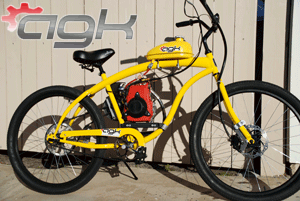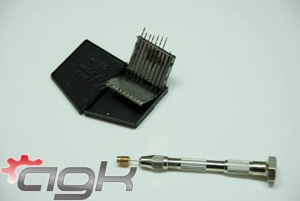 |
Here is our test bike.Santa Barbara, California makes an excellent location to build and test motorized bicycles due to the great beach weather we have year around.This bike is equiped with a 49cc HS 4 stroke engine using the EZM Q-matic gear reduction box.This bike is equiped with a front disc brake and goes 31 mph at 7500 rpm. |
 |
The first modification we have planned for this 49cc engine is to increase air flow. We will cover two possible methods of increasing air flow in this article. |
 |
Typically stock air filter assemblies are restrictive. We start by modifying the stock air filter box to accomodate our high flow air filter element. We drilled eight 7/8" holes in the outer cover. This will allow more air to enter the air filter box. |
 |
The inside of the air filter box cover has raised tabs which keep the stock air filter in place. Our high flow air filter element is thicker than stock so we have trimmed the tabs down. |
 |
This is the inside of the air filter box on the carburetor side. There is a plastic shield in the middle of the bolts that prevent the air filter from being sucked into the carburetor. |
 |
Here you can see we have drilled a 1/4" hole in the center of the shield to further increase air flow. We did not remove the shield as we do not want the vacuum created by the piston to suck the air filter element into the carb. |
 |
We have installed the high flow air filter element and re-installed the filter box cover. After some test rides and checking the spark plug it was evident that we have increased the air flow to our engine. When the engine gets too much air and not enough fuel it will not rev into the higher rpm range and the plug reading will be white. The next step is to increase the amount of fuel the engine receives so we can get our rpm's back up and a good plug reading. |
 |
The main jet needs to be removed from the carburetor. First remove the bowl from the bottom of the carb. Next you can remove the main jet using a thin flat blade screwdriver (shown in the picture). |
 |
Here is a small numbered drill bit set we purchased from ebay. We drilled our main jet with a #72 (.025") drill bit. This gave us the increase in fuel we needed and the plug looked tannish brown after a couple test rides. You may need to drill your main jet to a different size depending on your climate and elevation. The stock main jet is equivalent to a #75 (.021") drill bit. We recommend drilling your main jet with the next size larger drill bit which would be a #74. Run the engine and take a plug reading. Continue this process until the engine is running good and you are getting a good plug reading. Also be sure to get a plug reading from an engine that was running at a normal cruising rpm. Don't let the engine idle for a long time before checking the plug. Be careful not to drill the main jet too big as it's difficult to go back and make the hole smaller. |













